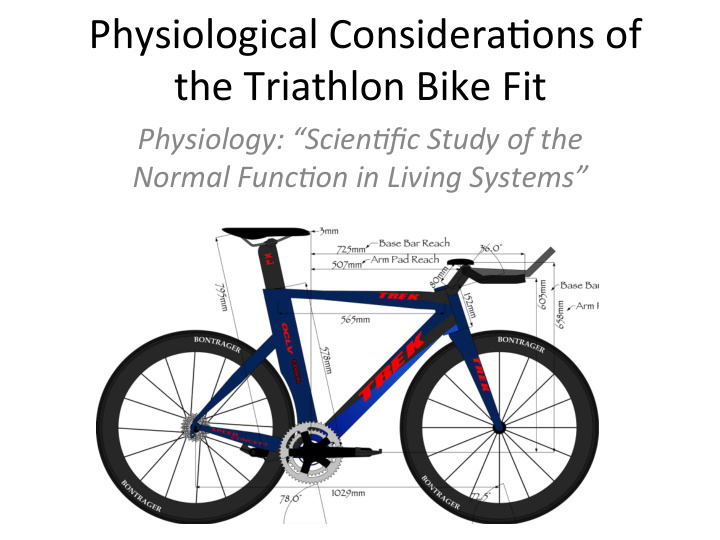



Physiological Considera1ons of the Triathlon Bike Fit Physiology: “Scien0fic Study of the Normal Func0on in Living Systems”
Cycling is NOT Normal! • Fixed/Symmetrical • Quadruped Posi1on • Pelvic Founda1on
Physiological Concerns Triathlon Bike FiCng Cycling cons1tutes only one “leg” of a Triathlon *Recover from Swimming *Prepare to Run
Tidal Volume Inspiratory Muscle Fa1gue
Tidal Volume & IMF
Ac1vity Specific Muscle Recruitment
Postural Muscle Recruitment
Tri Posi1oning
Effec1ve Hip Angle
Center of Gravity (COG)
Cockpit Reach
Cockpit Differen1al
Leg Extension
Cockpit
Symmetry
Tri-Pedaling Dynamics
Moxy Research & Bike FiCng 1. Tidal Volume: -Control Cadence and Ergo -Modify E-STA, HA, COG & Cockpit -Monitor SmO2 and tHb at QL & Vas1 2. Symmetry: -Control Cadence and Ergo -Modify Foot, Shoe, Pedal Interface -Monitor SmO2 and tHb at Deltoids, QL and/or Med-Lat Quads 3. Crank Length -Control Cadence and Ergo -Modify Crank Length -Monitor SmO2 and tHb at QL & Vas1
References • Allison McConnell (2015) Overcoming Muscle Fa1gue and Sports Psychology when Compe1ng in Triathlon. Peak Performance . • Mark D. Ricard , Patrick Hills-Meyer, Michael G. Miller and Timothy J. Michael. The Effects of Bicycle Frame Geometry on Muscle Ac1va1on and Power During a Wingate Anaerobic Test. Journal of Sports Science and Medicine (2006) 5, 25-32 • Defraeye T, Blocken B, Koninckx E, Hespel P, Carmeliet J. Aerodynamic study of different cyclist posi1ons: CFD analysis and full-scale wind-tunnel tests. J Biomech. 2010;43(7):1262-8. • Prilutsky BI, Gregory RJ. Analysis of muscle coordina1on strategies in cycling. IEEE Trans Rehabil Eng. 2000;8(3):362-70. • Gregor RJ, Wheeler JB. Biomechanical factors associated with shoe/pedal interfaces. Implica1ons for injury. Sports Med. 1994;17(2):117-31. • Hug F, Bendahan D, Le fur Y, Cozzone PJ, Grélot L. Heterogeneity of muscle recruitment panern during pedaling in professional road cyclists: a magne1c resonance imaging and electromyography study. Eur J Appl Physiol. 2004;92(3):334-42.
References • Browning, R.C., Gregor, R.J., & Broker, J.P. (1992). Lower extremity kine1cs in elite athletes in aerodynamic cycling posi1ons. Medicine and Science in Sports and Exercise, 24, S186. • Garside I, Doran A. Effects of Bicycle Frame Ergonomics on Triathlon 10-km running performance. J. Sports Sciences. 2000; 18(10):825-833 • Garcia-Lopez, J., Rodriguez-Marroyo, J.A., Juneau, C.E., Pele- teiro, J., Mar1nez, A.C., & Villa, J.G. (2008). Reference values and improvement of aerodynamic drag in profes- sional cyclists. Journal of Sports Sciences, 26 (3), 277–286. • Gnem P, Reichenbach S. Alpeter E, Widmer H, Hoppeler H. Influence of different racing posi1ons on metabolic cost in elite cyclists. Med Sci Sports Exerc. 1997 Jun;29(6):818-23 • Heil, D.P., Wilcox, A.R., & Quinn, C.M. (1995). Cardiore- spiratory responses to seat-tube angle varia1on during steady-state cycling. Medicine and Science in Sports and Exercise, 27 (5), 730–735. • Inigo San Millan (2011). Aero posi1on isn’t Everything. Bike Radar . • Lukes, R.A., Chin, S.B., & Haake, S.J. (2005). The understand- ing and development of cycling aerodynamics. Sports Engineering, 8 (2), 59–74.
References • Price D, Donne B. Effect of varia1on in seat tube angle at different seat heights on submaximal cycling performance in man. J. Sports Sci. 1997 Aug;15(4): 395-402 • Reiser, R.F., 2nd, Peterson, M.L., & Broker, J.P. (2002). Influ- ence of hip orienta1on on wingate power output and cycling technique. Journal of Strength and Condi0oning Research, 16 (4), 556–560. • Richard M, Hills-Meyer P, Miller M, Michael T. The Effects of Bicycle Frame Geometry on Muscle Ac1va1on and Power During a Wingate Anaerobic Test. J. Sports Sci Med. 2006 Mar; 5(1) 25-32 • Too, D. (1991). The effect of hip posi1on/configura1on on anaerobic power and capacity in cycling. Interna0onal Journal of Sports Biomechanics, 7, 359–370. • Welbergen, E., & Clijsen, L.P. (1990). The influence of body posi1on on maximal performance in cycling. European Journal of Applied Physiology and Occupa0onal Physiol- ogy, 61 (1-2), 138–142. • Umberger, B.R., Scheuchenzuber, H.J., & Manos, T.M. (1998). Differences in power output during cycling at different seat tube angles. Journal of Human Movement Studies, 35, 21–36.
Recommend
More recommend